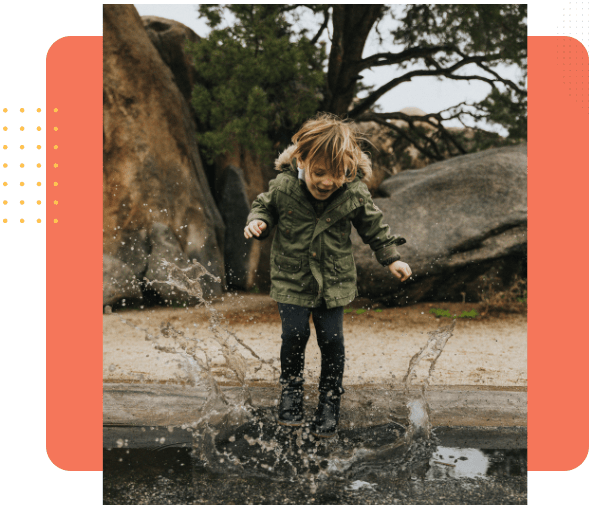“This is the real secret of life, to be completely engaged with what you are doing here and now. And instead of calling it to work, calling it to play.” Alan Watts,
“Play is often talked about as if it was a relief from serious learning, but for children, play is really the work of childhood” – Fred Rogers
Think back to when we were children, playing freely and often. What was the purpose of the thousands of different games that we made up? What was the purpose of building forts and going on treasure hunts in our neighborhoods? Why did we run around playing tag? It was all because the activity itself was intrinsically compelling and fulfilling. We laughed and cheered and lived in those moments because in those moments we felt alive. No wonder it was and is still hard for parents to wrest their children away from play, to return to the “other world.”.During play, new neural connections in the brain are created which are critically important for their cognitive and emotional development
Play is a means for children to learn and love and for adults as well. Play is an essential way of learning about the world. Doing things because we enjoy them, even when there is no goal in mind, leads us to discover new information, open new vistas, and provide us with joy and find unexpected beauty around us.
Play is a complex and multifaceted concept that goes beyond its superficial definition or obvious expression. It has deeper connotations related to creativity, learning, social interaction, personal expression, well-being, spirituality, and cultural significance. Recognizing and understanding these deeper connotations of play can provide insights into its rich and diverse role in human life and experience. Play can manifest in our lives as humor, art, music, poetry, dance, drama, and comedy, in addition to the obvious sports & games.
Play can also be a highly social activity to facilitate our social development and foster harmonious living. The French sociologist Émile Durkheim (1858-1917) coined the term “collective effervescence,’” describing the phenomenon that emerges when people come together in some form of unifying, excitement-inducing activity like cheering our favorite sports teams, participating in religious rituals, listening live to our favorite singers, dancing at weddings or in clubs.
Scientists across disciplines have come to study and realize the importance of play in brain development, and the role of play in creativity, innovation, and health in humans, and other species. Play is an intrinsically self-motivated behavior, not coerced or forced. It is an act or set of actions done for their own sake. Play is observed across various animal species. During the COVID years, animal shelters across the world experienced spikes in adoption rates. Whether it was out of compassion, or simply because there was more time at home, humans turned to animals to create more happiness in their lives. Animals are naturally playful creatures. Playing with animals brought people out of the stress of COVID, to a state of Play and joy.
Gordon Burghardt, a professor at The University of Tennessee, who studies animal behavior has defined five criteria to distinguish play from other behaviors. For Burghard, for something to play, it must not be fully functional. That is, the action is not purely utilitarian. Instead, the action is often repeated and starts spontaneously from an inward-generated design, not as a reaction to some outside stimulus. The action is also quite often missing a final act, such as with “play fighting” there is no killing or injury at the end. Play is an intrinsic yearning in us and a general drive in most organisms. Play is often the exploration of the unfamiliar and the unknown.

Burghardt further states, “One of the most important features of play is that it is only engaged when an animal is in a “relaxed field.” This means they are adequately fed, healthy, and not under imminent predator threat. This is why we see animals playing in captivity more than we do in the wild since they are relatively protected and their temporal needs are met. When animals in captivity are NOT playful, we know that they are stressed and the stress may come from the captivity itself.
Looking at the history of innovations, we also find acts of play weaved throughout history. We can even see a play at work in terms of learning strategies when we look at innovations, inventions, and creativity. In a TED talk by the science writer Steven Johnson, we learn the fascinating history of how the modern computer may have started with a flute. Along the way, there were the inventions of organs, push-lever pianos, and harpsichords, which were the first “typewriters.” The automated organ was invented in Baghdad over 1,000 years ago. Steven Johnson’s TED talk clearly demonstrates how some of the most transformative ideas and technologies, like the computer, didn’t emerge out of necessity, but instead from the strange delight of play. In his words “Necessity is not always the mother of invention. The playful state of mind is fundamentally exploratory, seeking out new possibilities in the world around us. That seeking is why so many experiences that started with simple delight and amusement eventually led to profound breakthroughs.”
Many great thinkers have talked about their work not as work but as a great play. Albert Einstein described the workings of his own mind as “combinatory play. Newton wrote, “I do not know what I may appear to the world, but to myself, I seem to have been only like a boy playing on the seashore, and diverting myself in now and then finding a smoother pebble or a prettier shell than ordinary, whilst the great ocean of truth lay all undiscovered before me.”
Research as combinatorial play is a concept introduced by Arthur Koestler, a Hungarian-British author, and polymath, in his book “The Act of Creation.” Koestler proposed creativity and innovation, including the process of scientific research, involving a form of play that combines and recombines existing ideas, concepts, and knowledge in novel and unexpected ways.

According to Koestler, creative thinking involves making connections between seemingly unrelated ideas or concepts through a process of “bisociation,” where different mental frameworks are combined in a playful and spontaneous manner. This process of combining and recombining existing ideas, concepts, and knowledge in new ways is referred to as “combinatorial play.” It is through this playful process of combining and recombining new insights and discoveries, innovations can emerge.
Research as combinatorial play suggests creativity and innovation are not solely reliant on originality or novelty, but rather on the ability to make new connections and combinations from existing knowledge and ideas. It emphasizes the importance of associative thinking, where diverse ideas, perspectives, and disciplines are brought together in a playful and spontaneous manner to generate new insights and possibilities. Reinforcing Koestler’s ideas the famous economist Joseph Schumpeter said, “The motherload of all inventions lies in recombination of existing ideas.”
This concept has implications for the way research is conducted and encourages interdisciplinary approaches, where different fields of knowledge are combined and recombined in novel ways to create new knowledge and insights. It highlights the value of diversity in thinking and the importance of a playful open-minded mindset in the research process.
The phrase “Play is the father of invention as necessity is the mother,” suggests both playfulness and necessity can be drivers of innovation and creativity. Just as necessity can lead to the invention of new solutions to address pressing needs or problems, playfulness can also foster a mindset of exploration, experimentation, and imagination that can lead to innovative ideas and solutions.
Diversity as Play
At a philosophical level, the diversity we observe in the natural world can be seen as a form of playful expression by nature.
Diversity in nature can be seen as a form of “combinatorial play,” as different elements of nature, such as species, genes, and ecosystems, are combined and recombined in novel ways, creating a rich tapestry of life forms and interactions. Just as the play involves the spontaneous and creative combination of different elements to generate new possibilities, nature’s diversity can be seen as a playful expression of unique l combinations and interactions among its various components. This aspect of diversity in nature can inspire us to appreciate and learn from the natural world, and to embrace play in our lives as a source of richness, innovation, resilience, and balance.
Playfulness can also be seen as a form of intrinsic motivation that encourages individuals to freely explore and experiment with different possibilities, without the pressure of achieving a specific outcome. Through play, individuals can engage in imaginative and creative activities that may not have an immediate practical purpose but can lead to unexpected discoveries and innovations. Play (which leisure can help to promote) is the wellspring from which innovation arises. Andrew Huberman, a professor at Stanford University and founder of the acclaimed podcast Huberman Lab, said,”
“Play is an exploration of contingencies in a low stake (keep adrenaline low) environment. Let’s see what happens. Play invokes endogenous opioids.” “If you are in frustration and strain, a sense of play is great because in play, you have focus, and you have intention and alertness. It keeps you light enough that there’s that dopamine release. As adults, we tend to be more demanding of ourselves. We don’t tend to embrace as much play.”
Susanna Crossman beautifully summarized what play is all about, “To play is to experiment, to discover, to recover pleasure, to uncover the secret, do the possible, the impossible, to invent and make the thing that is unmakeable, to cross the bridge you couldn’t cross, light wet fire, walk on water, fly. It is for an agoraphobic to sing in front of a crowd, dance, laugh and cry, paint a picture, forget worries, pain, and death, live outside of time, be in the flow, connect, disconnect, reconnect, imagine, make”.
We are hardwired to play. Play leads us to discover the mysteries of nature, and helps us to truly Flourish.
As a follow-up to this article, we recommended reading:

